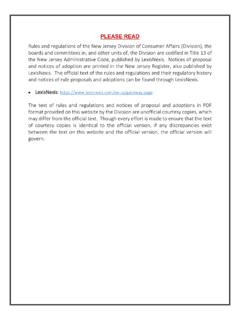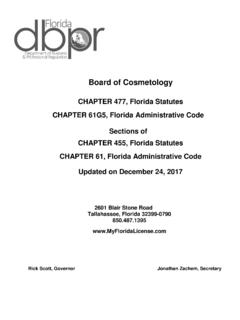Transcription of Religious education in English schools: Non‑statutory ...
1 Religious education in English schools: Non statutory guidance 20 10 Contents 1 Context 4 About this guidance 4 Scope of the guidance 4 Why updated guidance for RE? 4 The wider context for RE 6 2 The importance of RE 7 Spiritual, moral, social and cultural development 7 Personal development and well-being 7 Community cohesion 7 3 The Legal framework, rights and responsibilities 10 schools The role and responsibility of a standing advisory The role and responsibility of an agreed syllabus The legal basis of RE in the curriculum of maintained 10 The role and responsibility of the local authority 10 council on Religious education 12 Conference 13 The agreed syllabus 14 The RE curriculum in different types of schools 14 Inspection 16 The responsibilities
2 Of governors and headteachers 16 RE provision and the workforce 16 Parents and pupils 17 Complaints 18 4 Guidance on providing high-quality RE 19 Good practice for LAs working in partnership with Checklist for an effective partnership between an LA SACREs and ASCs 19 SACRE membership 21 SACREs and community cohesion 22 ASCs and the agreed syllabus 23 Breadth and depth in the agreed syllabus 23 and its SACRE/ASC 25 5 Good practice for school governors and headteachers 26 All schools 26 Every Child Matters 26 The responsibilities of governors and headteachers 26 Teachers and the school workforce 27 The right of withdrawal 27 2 Checklist for governors and headteachers 30 Checklist for managing the right of withdrawal 30 6 Good practice for people who manage, plan.
3 Teach and support RE 31 Provision of RE in the curriculum 31 Curriculum planning in RE 31 RE and the Early Years Foundation Stage 34 RE post 14 34 Qualifications 35 Checklist for people planning RE 40 Checklist for monitoring and evaluating RE provision 40 Checklist for planning and managing RE post 14 41 7 Support for RE 37 Religion and belief communities 37 Learning outside the classroom 38 8 Further references 42 Professional RE associations 42 Government agencies 42 Publications 44 Useful websites 45 3 1 Context About this guidance The purpose of this publication, produced by the Department for Children, Schools and Families (DCSF), is to support the provision of high-quality Religious education (RE) in maintained schools in England.
4 It provides clear non-statutory guidance about RE in the curriculum and the roles of those who have a responsibility for, involvement in or interest in the subject. The guidance is intended for: local authorities (LAs), standing advisory councils on Religious education (SACREs) and agreed syllabus conferences (ASCs) governors, headteachers, curriculum planners, teachers and trainee teachers of RE and others in maintained schools educational agencies, advisers, inspectors and consultants providers of initial teacher training (ITT) and continuing professional development (CPD), trainers and mentors representatives of religion and belief groups locally and nationally RE professional bodies, national and local. This guidance does not constitute an authoritative interpretation of the law; that is a matter for the courts.
5 Scope of the guidance This guidance replaces the elements of Circular 1/94 that relate to RE and explains that RE is a distinctive but core part of the basic curriculum for maintained schools in It relates to the Secretary of State s duty in relation to the curriculum. The curriculum for a maintained school must be a balanced and broadly based one which promotes the spiritual, moral, cultural, mental and physical development of pupils and of society, and prepares pupils for the opportunities, responsibilities and experiences of later life. 2 It also provides checklists, case studies and links to relevant websites for people involved in designing and teaching RE. Why updated guidance for RE? RE is an important curriculum subject. It is important in its own right and also makes a unique contribution to the spiritual, moral, social and cultural development of pupils and supports wider community cohesion.
6 The Government is keen to ensure all pupils receive high-quality RE. A number of important changes have taken place not just since 1994 but also since 2004 when the non-statutory national framework for RE ( the 1 Section 80(1), education Act 2002 2 Section 79 (1), School Standards and Framework Act 4 Framework ) was published. In particular new illustrative RE programmes of study for secondary education were published in 2007 and a new RE programme of learning for primary education in January 2010. These effectively replace pages 19-30 of the Framework and provide a basis for LAs, SACREs and their ASCs to develop statutory local syllabuses and for schools in certain cases to determine their own individual syllabuses. There have also been changes in both educational structures and in approaches to the wider curriculum: The Every Child Matters agenda and the Children s Plan have placed increased emphasis on personalisation and on the development of the whole child or young person in social and emotional as well as cognitive terms.
7 New types of school have come into existence, such as academies, and provision for children s early years has been extended. Each contributes to an educational vision which now routinely caters for the needs of young people up to the age of 19. The first minority faith schools to open in the state sector were Jewish. Since 1997, educational provision has included the establishment of the first maintained Muslim, Sikh and Hindu schools as voluntary-aided schools and the establishment of new Jewish voluntary-aided maintained schools. The curriculum is less prescriptive as to content than it was. Schools have the flexibility to provide more coherent and integrated cross-curricular learning experiences to complement discrete subject teaching tailored to the needs of their pupils and community.
8 In practice this means that subjects such as RE, history or citizenship might be taught discretely but also together within a humanities framework, with links to history and citizenship. Some schools might choose to focus on intensive teaching of RE in particular years. Consequently individual subjects may not feature in the curriculum under their traditional names or indeed be taught always in discrete subject areas. Cross-curricular dimensions such as identity, cultural diversity and community cohesion provide important unifying themes that help young people make sense of the world and give education relevance. They reflect the major ideas and challenges that face individuals and society and can provide a focus for work within and between subjects and across the curriculum as a whole.
9 Reflecting this flexibility the inspection of maintained schools by Ofsted focuses on school improvement, on educational outcomes for subjects, and on the curriculum as a whole, rather than on the time and detailed content devoted to individual subjects. It is also concerned with the well-being of every pupil. 5 However while schools are free to decide when and how subjects are taught and how much time is spent on each subject, they remain responsible for implementing the legally required syllabus (whether the locally agreed syllabus or their individual one) and for monitoring pupils progress. The wider context for RE The UK has a rich heritage of culture and diversity. This is continuing today in an era of globalisation and an increasingly interdependent world.
10 Religion and belief for many people forms a crucial part of their culture and identity. Religion and beliefs have become more visible in public life locally, nationally and internationally. The impact of religion on society and public life is constantly brought to public attention through extensive media coverage. The rapid pace of development in scientific and medical technologies and the environmental debate continue to present new issues which raise Religious , moral and social questions. The internet enables learning and encourages participation in public discussion of issues in a new and revolutionary way. 6 2 The importance of RE Religion and beliefs inform our values and are reflected in what we say and how we behave. RE is an important subject in itself, developing an individual s knowledge and understanding of the religions and beliefs which form part of contemporary society.
















